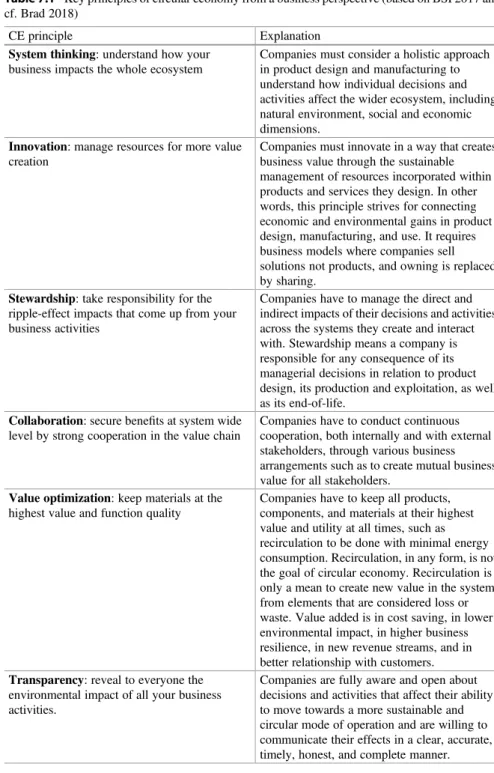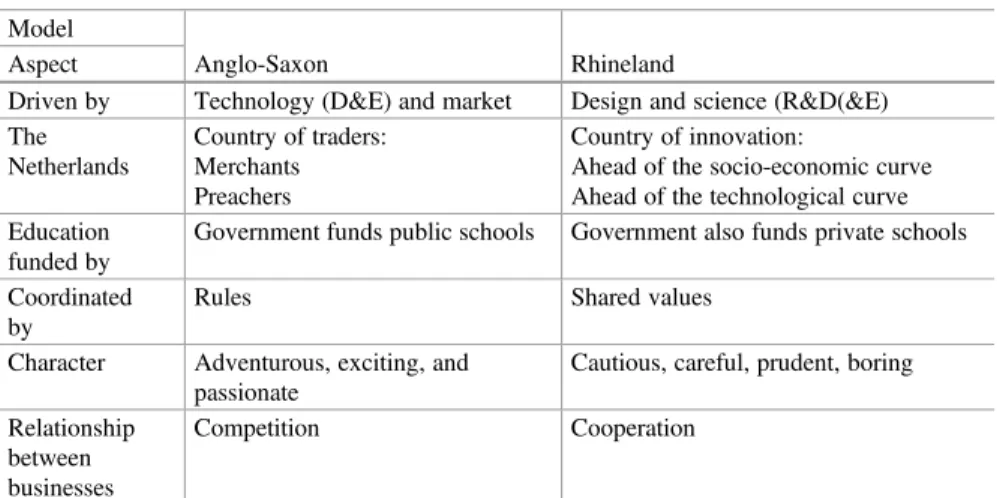In Part 2 of this book, I introduce the concept of Transformative Social-Ecological Innovation (TSEI) (Section 4.1) and define its use in the complex multi-actor and multi-level context of the sustainability transition. These findings from the literature have been combined into a conceptual framework (Sect. 3.9) and an analytical framework (Sect. 5.1) for Transformative Social-Ecological Innovation (TSEI).
Reader ’ s Guide
This chapter will provide an overview of the necessity and nature of the sustainability transition, starting with the paradox of prosperity (Sect. 2.1), the ecological limits of our planet (Sect. After this, the chapter gives a brief description of the nature ) of the sustainability transition (Sect. 2.4), and concludes with an argument to be more explicit about what comes after the Sustainable Development Goals (SDGs) of the UN's 2030 Agenda (Sect. 2.5).
Paradox of Prosperity
Broad prosperity includes economic, ecological and social aspects of well-being such as education, health, good governance, social equity, environmental quality and natural capital. The Broad Prosperity Monitor (CBS 2020) paints a worrying picture of the broad prosperity trend in the Netherlands (see Figure 2.1), with indicators related to natural capital steadily declining or not improving.
Ecological Limits of Our Planet
A report by the UN Panel on Biodiversity (IPBES 2019) shows that without rapid and extensive measures, hundreds of thousands of Fig. However, the target set in the Paris climate agreement for a maximum of 1.5 degrees of warming will certainly not be achieved, such is the painful conclusion of the UN climate panel (IPCC 2018).
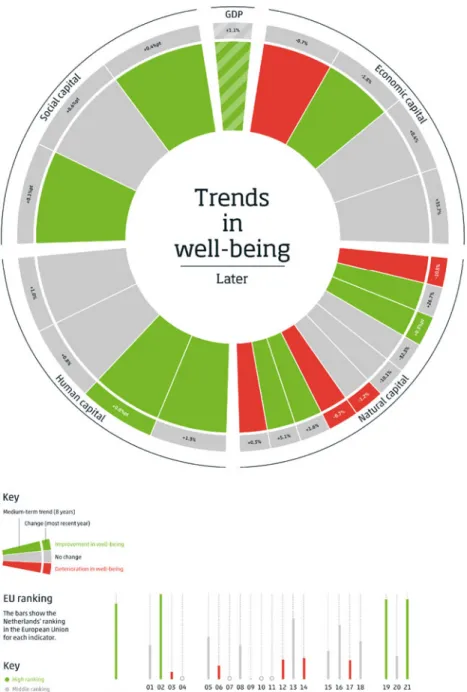
Emerging Security and Justice Challenges
Climate change is a threat to national and international security (state security) in two ways. First, climate change is contributing to higher instability in some of the world's most volatile regions.
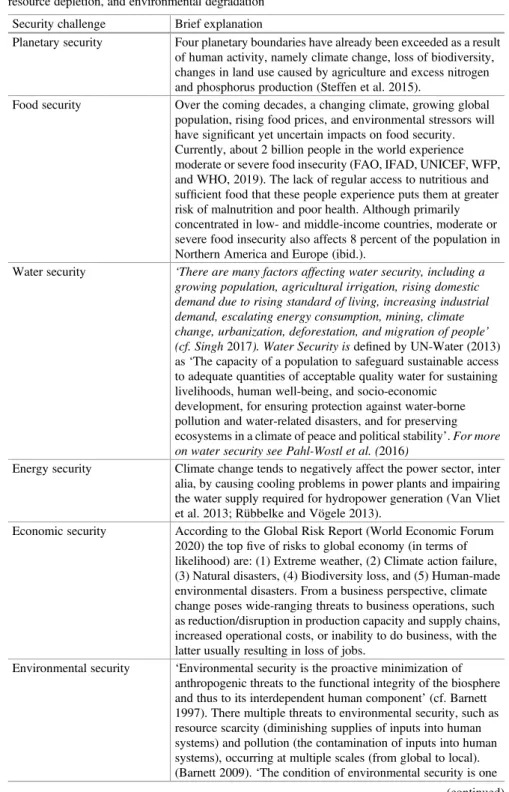
The Sustainability Transition: Humankind ’ s Quest
For example, 'The Arctic is still only protected by soft law instruments and the legal regime protecting the environment from reckless exploitation remains inadequate' (cf. In response to the Ministry's future policy, Rotmans (2019), contradicting Termeer (2019) ), argues that 2.4 The Sustainability Transition: Humanity's Search for a New Social Contract 21.
What ’ s Beyond the Sustainable Development Goals?
In doing so, I will embark on a search for a Natural Social Contract (Sec. 3.7) and its theoretical foundations with multiple dimensions and intersections (Sec. 3.8). For a better understanding and advancement of the process towards a Natural Social Contract, this chapter presents a conceptual framework for Transformative Social-Ecological Innovation (Sec. 3.9), and how this will happen at different levels of governance (Sec. 3.10).
What Is a Social Contract?
This chapter will also describe why we need a new social contract and what it should contain (section 3.6). In section 3.6 I will continue the discussion above on why we need a new social contract and what it should contain (section 3.6).
Human Progress Without Economic Growth?
2000, and eventually in the UN's Sustainable Development Goals (2015), as part of the '2030 Agenda for Sustainable Development'. Second, using GDP as the primary measure of our economic health does not accurately assess the economy or the state of the world and the people who live in it (Van den Bergh 2017; Stiglitz 2019a, b).
Redesigning Economics Based on Ecology
For example, some researchers argue that social inclusion is a necessary part of the circular economy (Korhonen et al. 2018). In addition to the circular economy, which is primarily focused on closing the loop of the product life cycle, the regenerative economy model is more holistic and is explicitly based on the natural principles of creating healthy ecosystems (see section 4.4).
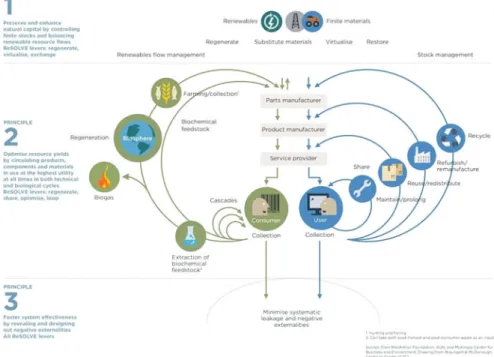
Debate on Role and Scope of the Free Market
It requires a debate on the role and scope of the free market and a critical reflection of the Anglo-Saxon and Rhineland model which currently determines the organization and functioning of capitalist societies. For the majority of policies, such as those related to climate change, agriculture, water management, nature, biodiversity, education, health care, housing, transport, it is important to engage in a debate about the role and scope of the free market.
Anglo-Saxon Model Versus Rhineland Model
Neoliberalism, or classical liberalism, is difficult to define, firstly because it consists of three main movements, each of which has a different view of the relationship between the economy and democracy and between the market and the state (Biebricher 2017). After the fall of the Berlin Wall in 1989, the capitalist camp was able to assert its political and socio-economic superiority.
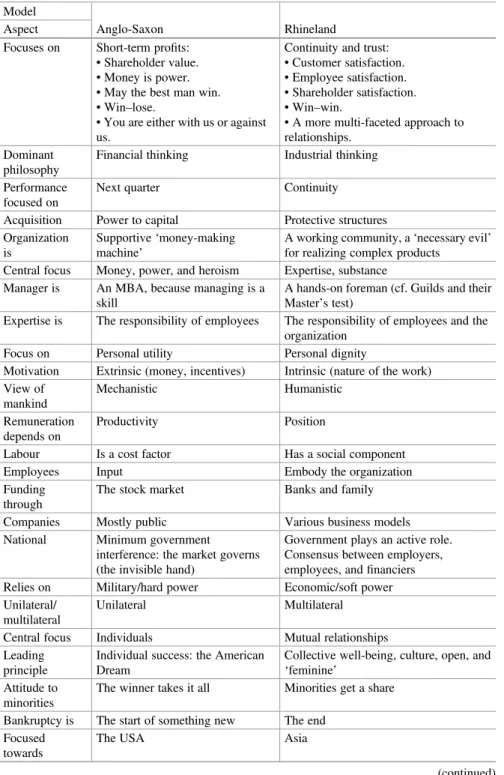
Looking for a New Social Contract
In other words, the social contract is expected to provide security and justice for all. Climate change and its effects are inextricably linked to complex issues of security and justice (see Huntjens et al. 2018) and therefore relate directly to the social contract.
A Natural Social Contract
The main differences between a natural social contract compared to existing social contracts are described in Table 3.2. Respect and care for all life (including ecosystems as a whole), solidarity and togetherness (as central to group life), environmental protection, and sustainable and shared management of shared resources, collective well-being, democracy and justice Overall goals of the social contract.
Dimensions and Crossovers Within a Natural Social Contract
This sociological aspect of a natural social contract is diametrically opposed to its individualistic character. More specifically, a natural social contract emphasizes the importance of values such as social and environmental stewardship.
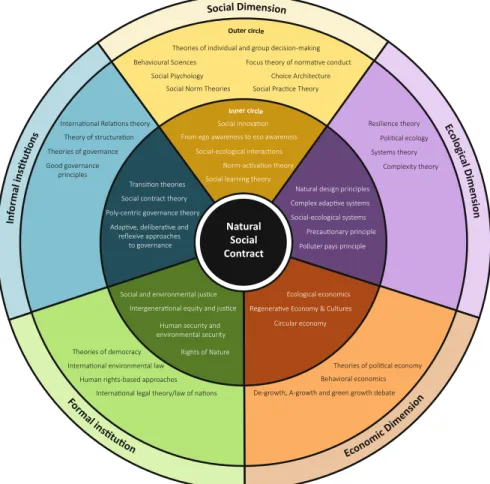
TSEI-Framework for Understanding and Advancing the Process
Finally, this dialectical model emphasizes 'the crucial role of actors' ability or skills to mobilize institutional logic and resources from the heterogeneous institutional environments in order to legitimize and support their change efforts' (cf. Transformative Social-Ecological Innovation (TSEI), as the engine of the sustainability transition, will help develop and implement a natural social contract.
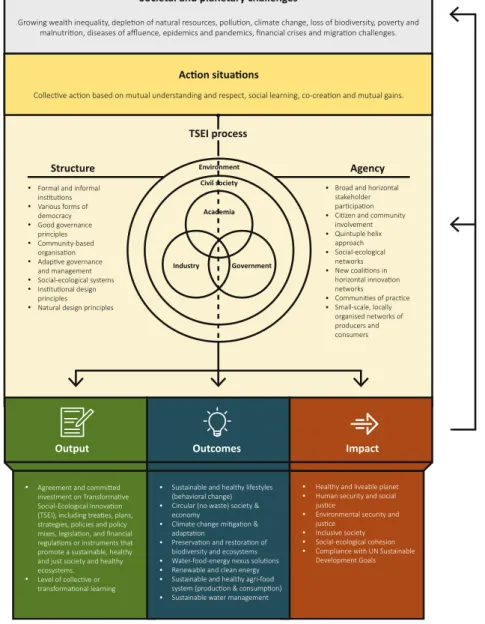
Development of a Natural Social Contract at Multiple
Third, gender inequality and other social inequalities are important topics that are often neglected in food system analysis and management (Schipanski et al. 2016). These challenges are particularly complex due to the multitude of actors involved in the process.
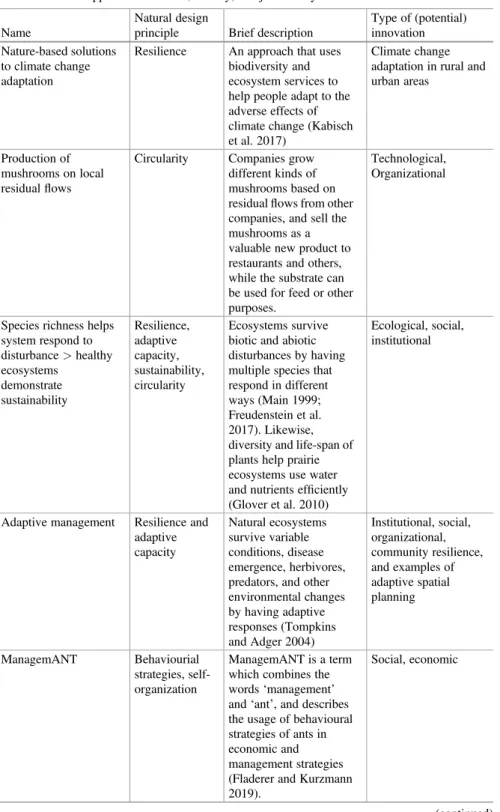
Theories and Concepts
De fi nition of Transformative Social-Ecological Innovation
Transition Studies
Several academics have criticized MPL and TM for ignoring the politics behind transitions (Avelino et al. 2016; Kern and Alber 2006; Meadowcroft 2009). Grin took Meadowcroft's critique to heart and adapted his approach to the practical aspects of policymaking through concepts such as reflective governance and two-track governance (Avelino et al. 2016; Grin 2016; Hendriks and Grin 2007).
Institutional Design Principles for Governing the Commons
For the sustainable management of shared resources, the institutional design principles for the control of the commons are increasingly used in various ongoing sustainability transitions, as highlighted in Chapters. From an analytical perspective, these natural design principles can be used as a benchmark for a transformation to a 4.4 Design principles from nature: benchmarks for a natural social contract 93.
Complex (Adaptive) Systems
The European Union's Common Agricultural Policy (CAP) currently accounts for 37.8% of the total EU budget (Rockström et al. 2020). One of the biggest challenges for the governance of future cities is the combination of climate change and the local urban heat island effect (Mohajerani et al. 2017; UN-Habitat 2020).
Adaptive, Re fl exive, and Deliberative Approaches
Social Learning, Policy Learning, and Transformational
However, a limitation in ACF is that advocacy coalitions derive their identity from core beliefs, they are conservative towards them and thus towards the policy positions they advocate (Weible et al. 2009). In other words, policy learning can have different levels of intensity (Pahl-Wostl et al. 2007).
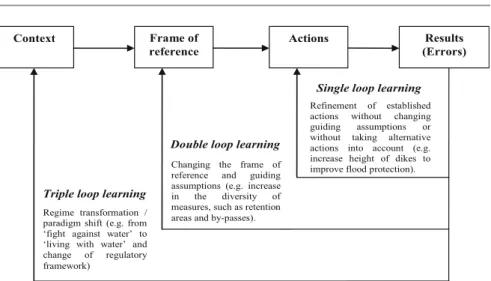
Shared Value, Multiple Value Creation, and Mutual Gains
The findings thus question the power of the notion of shared value creation when viewed as an equilibrium orientation' (cf. Pirson 2012). In addition to thinking about shared value, there is literature on the concept of integrated value creation (IVC), which resembles shared value creation, but is not exactly the same (Visser and Kymal (2015).
Effective Cooperation
Including these provisions makes the agreement more robust and greatly helps the parties who have to live with it and by it (Susskind and Cruikshank 2006). A central tenet of the MGA approach is that the vast majority of real-world negotiations involve parties who have more than one goal or concern in mind and more than one issue that can be addressed in the agreement they reach.
Transdisciplinary Approach, Living Labs, and Citizen Science
The achievement of planned results is also called the level of compliance, which is used as a measure of institutional effectiveness (Biermann et al. 2007, p. 10). As such, citizen science provides an important avenue for the co-creation of useful knowledge and solutions (Santha 2020).
The Art of Co-creation: Approaches, Principles, and Pitfalls
Table 4.4 provides an illustrative overview (non-exhaustive and in no particular order) of the different approaches available for co-creation. As such, path dependence can limit creativity and out-of-the-box thinking in a co-creation trajectory.
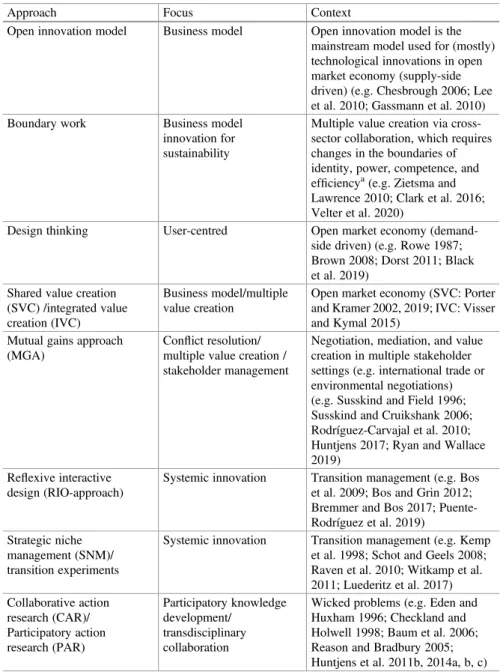
A Research and Innovation Agenda
Analytical Framework for Transformative Social-Ecological
The selected action situations are then analysed, focusing especially on sub-components such as initiation, process, format and content of the action situation. Output: the product resulting from one action situation or output from series or groups of closely related action situations.
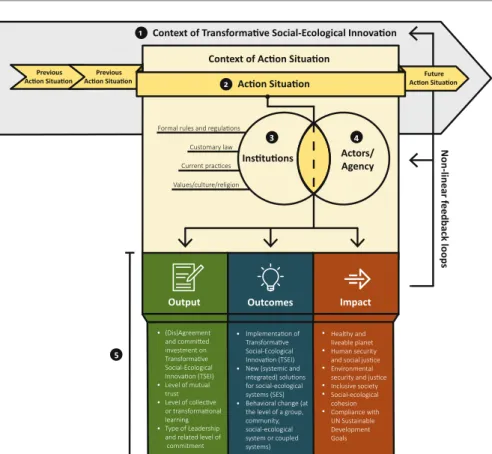
Power and Network Analysis
These three separate forms of power form a vertical typology of power, in which the different types of power correspond to different degrees of aggregation (actors, structures, systems). Both the vertical and horizontal typology of power presented here are included in the power analysis within the TSEI framework (see Fig.5.2).
Framework for Analysing Different Levels of Collective
Single loop learning (SLL) is a refinement of established actions to improve performance without changing guiding assumptions or considering alternative actions. Triple loop learning (TLL) is a transformation of context to change factors that determine the frame of reference.
Collaborative Action Research
For a number of reasons, action research is well suited to provide actionable knowledge (Coghlan and Brannick 2002). Action research yields relevant knowledge through the involvement of practitioners and because the research itself is conducted in the relevant context.
Challenges and Developments
NewForesight and Commonland 2017; Godfray et al. 2010; SAPEA 2020) justifies a radical transition to a sustainable and healthy agri-food system. A societal transformation towards a Natural Social Contract cannot be achieved without a transition to a sustainable and healthy agri-food system.
NWA Programme ‘ Transition to a Sustainable Food System ’
This is to gain insight into how their activities can contribute to or limit the transition to a sustainable food system. How do the many sustainability initiatives in the Netherlands actually contribute to the transition to a sustainable food system at home and abroad?
Nature-Inclusive and Regenerative Agriculture
The exploratory research conducted by my research group provides some preliminary but important insights into which factors determine the success and/or failure of a transition to inclusive nature agriculture in the Netherlands. Our investigations, so far, highlight the importance of governance in the transformation towards inclusive nature agriculture.
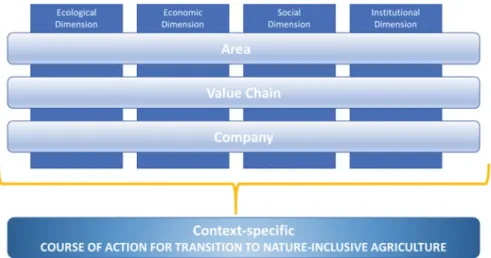
Closing the Gaps Between Citizens, Farmers, and Nature
Citizen Farms Cooperative aims to reconnect people with the source of their food: 'their' farmers. Overall, these projects aim to build a community that coexists with the natural environment and reconnect people with the source of their food through mutually supportive relationships between farmers and consumers.
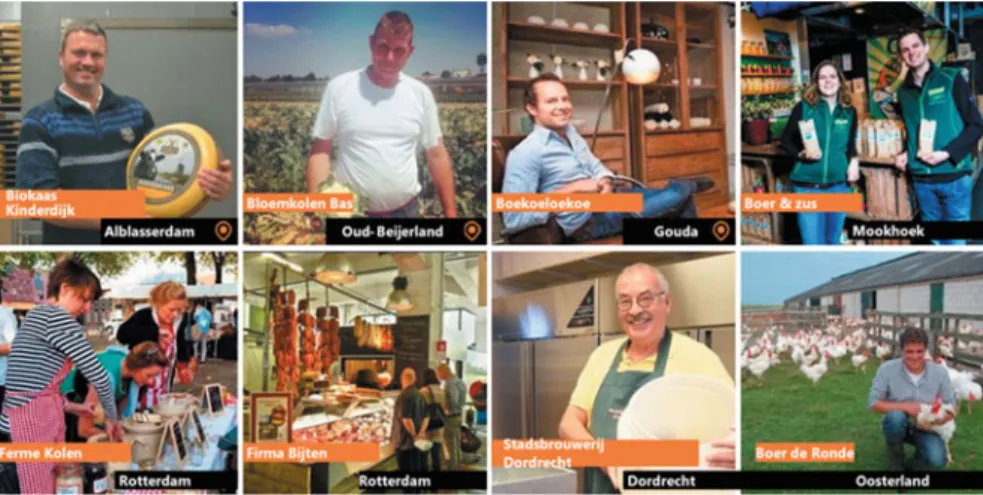
Measuring Sustainability and Health Aspects of Our Food
This has many positive effects, such as fairer food, without unwanted scale-up and the shortest possible food chain, without delegating control to supermarkets (Burgerboerderijen 2019). There are also other topics of social importance, such as the relationship between citizen and farmer, animal welfare, landscape, nature, biodiversity and cultural history.
South Holland Food Family: Transition Towards a Sustainable
Table 6.1 provides a brief description of the nature of these action situations and the formal or informal institutional change that took place. The results are indicative of the importance of institutional structures as both facilitating (i.e. the province's policies) and constraining (e.g. land ownership) transition dynamics.
Urban Challenges and Developments
Nowhere in human culture is the central role of cooperation and sharing more evident than in the city” (cf. Agyeman and McLaren 2017). Short-term rental platforms can also cause property prices to skyrocket and negatively impact local liveability (cf. JRC 2019).
Climate-Resilient and Healthy Cities
An example in the Netherlands is 'The Sustainable Square Kilometer', an area around Leiden Central Station where a sustainable transformation is taking place to become the most sustainable kilometer in the Netherlands in 2025. The transition to climate-proof and healthy cities will raise normative questions about what makes cities climate-proof and healthy and who should bear the costs thereof (Eriksen et al. 2015).
Feeding and Greening Megacities
However, transport is only one factor in the total carbon count of food, while the carbon footprint is only one measure of sustainability, apart from social, economic and other environmental dimensions (Morgan 2009). One important advantage of local food systems is, for example, a smaller separation between farmers, consumers and nature (Sect. 6.4).
From Linear to Circular and Regenerative Cities
In general, green-blue networks are considered one of the structural building blocks of circular cities, as well as natural ways of closing urban loops (Pötz and Bleuzé 2016). One of the main findings of the Cities of the Future report (UN-Habitat 2020) is that future cities need citizen-centered management, where residents will change from being a subject of observation to an active partner in city management.
Collaboration for the City of the Future
2004). The main benefit: What the new dynamics of business ecosystems mean for strategy, innovation and sustainability. 2018). The Wizard and the Prophet: Two remarkable scientists and their dueling visions to shape the world of tomorrow.
